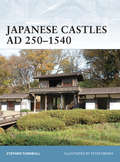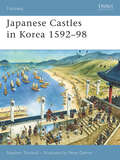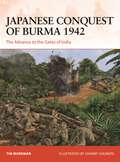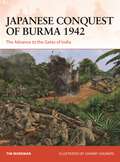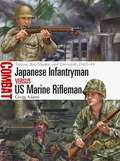- Table View
- List View
Japanese Army Air Force Aces 1937–45 (Aircraft of the Aces #13)
by Henry Sakaida Grant RaceLittle has been published in English on the Japanese Army Air Force (JAAF), let alone its most successful fighter pilots no less than 150 of them achieved ace status during eight years of near-constant war, and they are all listed in this volume. From the arid plains of the Mongolian border region to the lush jungles of New Guinea, the JAAF was more than a match for the many opponents it fought against for control of the skies. Indeed, even when the mighty Allied war machine proved almost overwhelming from early 1944 onwards, the elite fighter pilots of the various sentais within the JAAF fought on with near-fanatical loyalty in defence of the Home Islands. Aircraft of the Aces 13 and 22 are also available in a single volume as 'Aces of the Rising Sun 1937-1945'.
Japanese Army in World War II: The South Pacific and New Guinea, 1942–43 (Battle Orders)
by Gordon L. RottmanThe 1941 Japanese Pacific onslaught saw the defeat of Allied forces on all fronts, with the Philippines, Netherlands East Indies, and Commonwealth possessions falling under their control. During 1942-43, the Japanese consolidated their gains and redeployed forces in an attempt to break the Southern Lifeline between America and Australia. These plans were affected by the defeat at Midway, which forced the Japanese onto the defensive. This book examines Japanese forces employed in the follow-on conquests of 1942-43, and describes how unit organization, weaponry, and equipment were found lacking in the harsh environment of the Solomon Islands and on New Guinea.
Japanese Army in World War II: Conquest of the Pacific 1941–42 (Battle Orders)
by Gordon L. RottmanThe Japanese conquest of the Pacific comprised of a complex series of widely scattered operations; their intent was to neutralize American, Commonwealth, and Dutch forces, seize regions rich in economic resources, and secure an outer defense line for their empire. Although their conquest was successful, the forces deployed from Japan and China were not always ideally trained, equipped and armed. The South Seas and tropics proved challenging to these soldiers who were used to milder climates, and they were a less lethal enemy on the Chinese mainland. This book examines the overall structure of the Imperial Japanese Army (IJA), the forces in existence at the beginning of World War II and the organization of the forces committed to the conquest of the Pacific.
Japanese Army in World War II: Conquest of the Pacific 1941–42 (Battle Orders)
by Gordon L. RottmanThe Japanese conquest of the Pacific comprised of a complex series of widely scattered operations; their intent was to neutralize American, Commonwealth, and Dutch forces, seize regions rich in economic resources, and secure an outer defense line for their empire. Although their conquest was successful, the forces deployed from Japan and China were not always ideally trained, equipped and armed. The South Seas and tropics proved challenging to these soldiers who were used to milder climates, and they were a less lethal enemy on the Chinese mainland. This book examines the overall structure of the Imperial Japanese Army (IJA), the forces in existence at the beginning of World War II and the organization of the forces committed to the conquest of the Pacific.
Japanese Army in World War II: The South Pacific and New Guinea, 1942–43 (Battle Orders #14)
by Gordon L. RottmanThe 1941 Japanese Pacific onslaught saw the defeat of Allied forces on all fronts, with the Philippines, Netherlands East Indies, and Commonwealth possessions falling under their control. During 1942-43, the Japanese consolidated their gains and redeployed forces in an attempt to break the Southern Lifeline between America and Australia. These plans were affected by the defeat at Midway, which forced the Japanese onto the defensive. This book examines Japanese forces employed in the follow-on conquests of 1942-43, and describes how unit organization, weaponry, and equipment were found lacking in the harsh environment of the Solomon Islands and on New Guinea.
Japanese Atrocities in Nanjing: The Nanjing Massacre and Post-Massacre Social Conditions Recorded in German Diplomatic Documents
by Suping LuThis book presents a collection of annotated English translations of German diplomatic documents—including telegrams, dispatches and reports—sent to the Foreign Office in Berlin and the German Ambassador in Hankou, China, by German diplomatic officials in Nanjing, and detailing Japanese atrocities and the conditions in and around Nanjing during the early months of 1938. The author visited the German Federal Archives (Bundesarchiv) and the German Foreign Ministry Archives (Auswärtiges Amt Archiv) in Berlin, where these documents are currently archived, in 2008, 2016, and 2017 to locate and retrieve them. These diplomatic documents are of significant value in that they provide both detailed information and wide coverage, from different locations and on various topics. Further, the information offered is unique in a number of ways. First, the events were recorded from the perspective of Germans, citizens of a country that was a close ally of Japan, and second, these documents are not included in any other source. As such, these archival primary sources represent an invaluable addition to the research literature on the Nanjing Massacre and will undoubtedly benefit researchers and scholars for generations to come.
Japanese Castles 1540–1640 (Fortress #5)
by Peter Dennis Dr Stephen TurnbullThe landscape of 16thand 17th-century Japan was dominated by the graceful and imposing castles constructed by the powerful 'daimyo' of the period. In this the most turbulent era in Japanese history, these militarily sophisticated structures provided strongholds for the consolidation and control of territory, and inevitably they became the focus for many of the great sieges of Japanese history: Nagashino (1575), Kitanosho (1583), Odawara (1590), Fushimi (1600), Osaka (1615) and Hara (1638), the last of the battles that brought an end to a period of intense civil war. This title traces their development from the earliest timber stockades to the immense structures that dominated the great centres of Osaka and Edo.
Japanese Castles 1540–1640 (Fortress)
by Peter Dennis Stephen TurnbullThe landscape of 16thand 17th-century Japan was dominated by the graceful and imposing castles constructed by the powerful 'daimyo' of the period. In this the most turbulent era in Japanese history, these militarily sophisticated structures provided strongholds for the consolidation and control of territory, and inevitably they became the focus for many of the great sieges of Japanese history: Nagashino (1575), Kitanosho (1583), Odawara (1590), Fushimi (1600), Osaka (1615) and Hara (1638), the last of the battles that brought an end to a period of intense civil war. This title traces their development from the earliest timber stockades to the immense structures that dominated the great centres of Osaka and Edo.
Japanese Castles AD 250–1540 (Fortress #74)
by Peter Dennis Stephen TurnbullDr Stephen Turnbull is internationally recognised for his research into and writing on Japanese military history. Here he applies his scholarship to an account of the evolution of Japanese defensive architecture and engineering, from early earthworks through to wooden and earth castles and, finally, the emergence of the stone towers that are so characteristic of the samurai. He also plots the adaptation of Japanese castles to accommodate the introduction of firearms. With unpublished photographs from the author's private collection and full-colour artwork, including detailed cutaways, this is an essential guide to the fascinating development of Japanese castles.
Japanese Castles AD 250–1540 (Fortress #74)
by Peter Dennis Stephen TurnbullDr Stephen Turnbull is internationally recognised for his research into and writing on Japanese military history. Here he applies his scholarship to an account of the evolution of Japanese defensive architecture and engineering, from early earthworks through to wooden and earth castles and, finally, the emergence of the stone towers that are so characteristic of the samurai. He also plots the adaptation of Japanese castles to accommodate the introduction of firearms. With unpublished photographs from the author's private collection and full-colour artwork, including detailed cutaways, this is an essential guide to the fascinating development of Japanese castles.
Japanese Castles in Korea 1592–98 (Fortress)
by Peter Dennis Stephen TurnbullThe Japanese invasion and occupation of Korea, which lasted from 1592 to 1598, was the only occasion in Japanese history when samurai aggression was turned against a foreign country. During the occupation of Korea the Japanese built 25 wajo or castles. Unlike the castles built in Japan, these fortifications were never developed or modernized after the Japanese departure. The details of late 16th-century castle construction are therefore better preserved than at many other sites. Written by Stephen Turnbull, an expert in the subject, this book examines the castles built by the Japanese in Korea, as well as the use made of existing Korean fortifications, particularly city walls. This resulted in curious hybrid fortifications that dominated the landscape until the Japanese were pushed out of the peninsula by a furious onslaught from huge Chinese armies.
Japanese Castles in Korea 1592–98 (Fortress #67)
by Stephen TurnbullThe Japanese invasion and occupation of Korea, which lasted from 1592 to 1598, was the only occasion in Japanese history when samurai aggression was turned against a foreign country. During the occupation of Korea the Japanese built 25 wajo or castles. Unlike the castles built in Japan, these fortifications were never developed or modernized after the Japanese departure. The details of late 16th-century castle construction are therefore better preserved than at many other sites. Written by Stephen Turnbull, an expert in the subject, this book examines the castles built by the Japanese in Korea, as well as the use made of existing Korean fortifications, particularly city walls. This resulted in curious hybrid fortifications that dominated the landscape until the Japanese were pushed out of the peninsula by a furious onslaught from huge Chinese armies.
Japanese Combined Fleet 1941–42: The IJN at its zenith, Pearl Harbor to Midway (Fleet #1)
by Mark StilleLaunching Osprey's new Fleet series, this is a spectacularly illustrated, concise and comprehensive account of the Imperial Japanese Navy's striking force at the height of its power.The Imperial Japanese Navy (IJN) entered the Pacific War as one of the most formidable navies in the world, and its combat power was concentrated into one force, the Combined Fleet. In the months that followed Pearl Harbor it enjoyed an unrivaled string of victories, shattering American, British, Australian, and Dutch naval forces. This period of expansion and constant victories ended at the Battle of Midway, after which the Combined Fleet was forced onto the defensive. In this book, Mark Stille draws on his decades of IJN research to explain what made the Combined Fleet the fighting force that it was. Packed with superb original artwork, explanatory 3D diagrams and maps, it examines the fleet's doctrine, innovative tactics and powerful warships. It also details the qualities and importance of IJN leadership, logistics, naval infrastructure, and Japan's shipbuilding capability, and gives an account and analysis of the IJN's combat performance during these crucial months – not just in the famous carrier battles, but also exploring lesser-known elements such as IJN amphibious forces and land-based aviation.
Japanese Combined Fleet 1941–42: The IJN at its zenith, Pearl Harbor to Midway (Fleet #1)
by Mark StilleLaunching Osprey's new Fleet series, this is a spectacularly illustrated, concise and comprehensive account of the Imperial Japanese Navy's striking force at the height of its power.The Imperial Japanese Navy (IJN) entered the Pacific War as one of the most formidable navies in the world, and its combat power was concentrated into one force, the Combined Fleet. In the months that followed Pearl Harbor it enjoyed an unrivaled string of victories, shattering American, British, Australian, and Dutch naval forces. This period of expansion and constant victories ended at the Battle of Midway, after which the Combined Fleet was forced onto the defensive. In this book, Mark Stille draws on his decades of IJN research to explain what made the Combined Fleet the fighting force that it was. Packed with superb original artwork, explanatory 3D diagrams and maps, it examines the fleet's doctrine, innovative tactics and powerful warships. It also details the qualities and importance of IJN leadership, logistics, naval infrastructure, and Japan's shipbuilding capability, and gives an account and analysis of the IJN's combat performance during these crucial months – not just in the famous carrier battles, but also exploring lesser-known elements such as IJN amphibious forces and land-based aviation.
Japanese Combined Fleet 1942–43: Guadalcanal to the Solomons Campaign (Fleet #8)
by Mark StilleA superbly illustrated account of the Japanese Navy during the fierce battles of Guadalcanal and the Solomons, explaining how and why it fought as it did. Contrary to myth, the Imperial Japanese Navy was not a shattered force after its defeat at Midway. In this book, Pacific War expert Mark Stille examines the IJN's Combined Fleet during the Guadalcanal and Solomons campaigns, when it was reorganized and was forced to fight a grinding battle of attrition against the US Navy. The early surface battles in the Guadalcanal campaign played into the strength of the Combined Fleet, which had long trained for night combat. The IJN's rebuilt carrier force also performed well and managed to score its most clearcut victory against the USN's carriers of the entire war, at the battle of Santa Cruz, but the overall Guadalcanal campaign ended in disaster. The result was that the IJN was unwilling to engage in a major struggle for the Central and Northern Solomons, instead using only its destroyer force and land-based air power to fight a delaying action. However, this was costly and weakened the Combined Fleet for the rest of the war. Using the most recent sources and illustrated with superb artwork, 3D diagrams and maps, the book is the first attempt to focus on how the Combined Fleet fought these campaigns, and, most importantly, how their results affected the rest of the war.
Japanese Combined Fleet 1942–43: Guadalcanal to the Solomons Campaign (Fleet #8)
by Mark StilleA superbly illustrated account of the Japanese Navy during the fierce battles of Guadalcanal and the Solomons, explaining how and why it fought as it did. Contrary to myth, the Imperial Japanese Navy was not a shattered force after its defeat at Midway. In this book, Pacific War expert Mark Stille examines the IJN's Combined Fleet during the Guadalcanal and Solomons campaigns, when it was reorganized and was forced to fight a grinding battle of attrition against the US Navy. The early surface battles in the Guadalcanal campaign played into the strength of the Combined Fleet, which had long trained for night combat. The IJN's rebuilt carrier force also performed well and managed to score its most clearcut victory against the USN's carriers of the entire war, at the battle of Santa Cruz, but the overall Guadalcanal campaign ended in disaster. The result was that the IJN was unwilling to engage in a major struggle for the Central and Northern Solomons, instead using only its destroyer force and land-based air power to fight a delaying action. However, this was costly and weakened the Combined Fleet for the rest of the war. Using the most recent sources and illustrated with superb artwork, 3D diagrams and maps, the book is the first attempt to focus on how the Combined Fleet fought these campaigns, and, most importantly, how their results affected the rest of the war.
The Japanese Comfort Women and Sexual Slavery during the China and Pacific Wars (War, Culture and Society)
by Caroline NormaThe Japanese military was responsible for the sexual enslavement of thousands of women and girls in Asia and the Pacific during the China and Pacific wars under the guise of providing 'comfort' for battle-weary troops. Campaigns for justice and reparations for 'comfort women' since the early 1990s have highlighted the magnitude of the human rights crimes committed against Korean, Chinese and other Asian women by Japanese soldiers after they invaded the Chinese mainland in 1937. These campaigns, however, say little about the origins of the system or its initial victims.The Japanese Comfort Women and Sexual Slavery during the China and Pacific Wars explores the origins of the Japanese military's system of sexual slavery and illustrates how Japanese women were its initial victims.
The Japanese Comfort Women and Sexual Slavery during the China and Pacific Wars (War, Culture and Society)
by Caroline NormaThe Japanese military was responsible for the sexual enslavement of thousands of women and girls in Asia and the Pacific during the China and Pacific wars under the guise of providing 'comfort' for battle-weary troops. Campaigns for justice and reparations for 'comfort women' since the early 1990s have highlighted the magnitude of the human rights crimes committed against Korean, Chinese and other Asian women by Japanese soldiers after they invaded the Chinese mainland in 1937. These campaigns, however, say little about the origins of the system or its initial victims.The Japanese Comfort Women and Sexual Slavery during the China and Pacific Wars explores the origins of the Japanese military's system of sexual slavery and illustrates how Japanese women were its initial victims.
Japanese Conquest of Burma 1942: The Advance to the Gates of India (Campaign)
by Tim MoremanThis book provides a fascinating exploration of the Japanese conquest of Burma, as the Allied forces were forced back in disarray to India and China.The Japanese invasion of Burma in January 1942 marked the beginning of the single longest campaign of World War II. In the Burmese jungles, the battle-hardened, highly trained and lightly equipped Imperial Japanese Army quickly proved itself a vastly superior fighting force in clashes against the British, Indian and Gurkha troops that formed Burma Army and Chinese nationalist forces deployed in eastern Burma. This superbly illustrated book narrates Burma Corps' epic fighting retreat northwards, carried out mostly in contact with the enemy and across hundreds of miles of highly malarial and extremely difficult terrain, to safety in India. Among the battles covered are the disaster at the Sittang Bridge on 22 February 1942 (where 17th Indian Division was all but destroyed), the fall of Rangoon in March 1942 and the clashes at Yenangyaung, Monywa and Shwegyin. The performance of the opposing commanders and forces is also examined in detail, highlighting the success of Japanese aggressive light infantry tactics, which ruthlessly exploited the cover and concealment provided by the jungle to outflank, bypass and encircle their bewildered enemy.
Japanese Conquest of Burma 1942: The Advance to the Gates of India (Campaign #384)
by Tim MoremanThis book provides a fascinating exploration of the Japanese conquest of Burma, as the Allied forces were forced back in disarray to India and China.The Japanese invasion of Burma in January 1942 marked the beginning of the single longest campaign of World War II. In the Burmese jungles, the battle-hardened, highly trained and lightly equipped Imperial Japanese Army quickly proved itself a vastly superior fighting force in clashes against the British, Indian and Gurkha troops that formed Burma Army and Chinese nationalist forces deployed in eastern Burma. This superbly illustrated book narrates Burma Corps' epic fighting retreat northwards, carried out mostly in contact with the enemy and across hundreds of miles of highly malarial and extremely difficult terrain, to safety in India. Among the battles covered are the disaster at the Sittang Bridge on 22 February 1942 (where 17th Indian Division was all but destroyed), the fall of Rangoon in March 1942 and the clashes at Yenangyaung, Monywa and Shwegyin. The performance of the opposing commanders and forces is also examined in detail, highlighting the success of Japanese aggressive light infantry tactics, which ruthlessly exploited the cover and concealment provided by the jungle to outflank, bypass and encircle their bewildered enemy.
Japanese Fortified Temples and Monasteries AD 710–1602 (Fortress #34)
by Peter Dennis Stephen TurnbullFrom the 10th century onwards the great Japanese monastic foundations of Nara and Mount Hiei maintained large armies of warlike monks. The tempestuous political rivalries that developed between the different orders of monks and religiously inspired laymen ensured that their temples and monasteries had to be securely sited and robustly defended. This books recreates these enormous fortified monasteries and temples, tracing their development from the 10th century through to the Sengoku Jidai period and the rise of the power of the shogunate under Tokugawa Ieyasu.
Japanese Fortified Temples and Monasteries AD 710–1602 (Fortress #34)
by Peter Dennis Stephen TurnbullFrom the 10th century onwards the great Japanese monastic foundations of Nara and Mount Hiei maintained large armies of warlike monks. The tempestuous political rivalries that developed between the different orders of monks and religiously inspired laymen ensured that their temples and monasteries had to be securely sited and robustly defended. This books recreates these enormous fortified monasteries and temples, tracing their development from the 10th century through to the Sengoku Jidai period and the rise of the power of the shogunate under Tokugawa Ieyasu.
The Japanese Home Front 1937–45 (Elite)
by Philip JowettFrom the beginning of the Second Sino-Japanese War in 1937 until the Japanese surrender in August 1945, a multitude of military and civil-defence forces strove to support the Japanese war effort and latterly prepared to defend the Home Islands against invasion. During World War II, Japan was the world's most militarized society and by 1945 nearly every Japanese male over the age of 10 wore some kind of military attire, as did the majority of women and girls. In this volume, Philip Jowett reveals the many military and civil-defence organizations active in wartime Japan, while specially commissioned artwork and carefully chosen archive photographs depict the appearance of the men, women and children involved in the Japanese war effort in the Home Islands throughout World War II.
The Japanese Home Front 1937–45 (Elite #240)
by Philip JowettFrom the beginning of the Second Sino-Japanese War in 1937 until the Japanese surrender in August 1945, a multitude of military and civil-defence forces strove to support the Japanese war effort and latterly prepared to defend the Home Islands against invasion. During World War II, Japan was the world's most militarized society and by 1945 nearly every Japanese male over the age of 10 wore some kind of military attire, as did the majority of women and girls. In this volume, Philip Jowett reveals the many military and civil-defence organizations active in wartime Japan, while specially commissioned artwork and carefully chosen archive photographs depict the appearance of the men, women and children involved in the Japanese war effort in the Home Islands throughout World War II.
Japanese Infantryman vs US Marine Rifleman: Tarawa, Roi-Namur, and Eniwetok, 1943–44 (Combat #75)
by Gregg AdamsFeaturing evocative artwork plates and carefully selected photographs, this book assesses the US Marines and Japanese troops who contested the islands of Tarawa, Roi-Namur, and Eniwetok during 1943–44. On November 20, 1943, amphibious vehicles carrying Marines of the 2d Marine Division reached the shores of Betio Island in the Tarawa Atoll, defended by a determined Japanese garrison that would fight to the last man. This began a test by combat of over two decades of US studies, analyses, and planning for capturing and defending naval bases in Micronesia. The Tarawa assault was followed in February 1944 by the rapid capture of the Kwajalein and Eniwetok atolls in the Marshall Islands. In these battles US Marines fought a mix of Imperial Japanese Navy and Imperial Japanese Army ground units. All but a handful of the defenders, whether they were organized ground combat troops or infantry improvised from aviators and service troops, were determined to die for the Emperor while killing as many of the enemy as possible. In this study, Gregg Adams shows how the US Marine Corps and US Navy drew upon these pivotal actions to improve their tactics, organization, and equipment for the next round of amphibious operations. He also explains how their Japanese opponents – realizing that isolated island garrisons were doomed to destruction or isolation if the Imperial Japanese Navy could not defeat the US Navy at sea – moved from seeking to repel an invasion to one inflicting maximum American casualties through prolonged defensive fighting.







